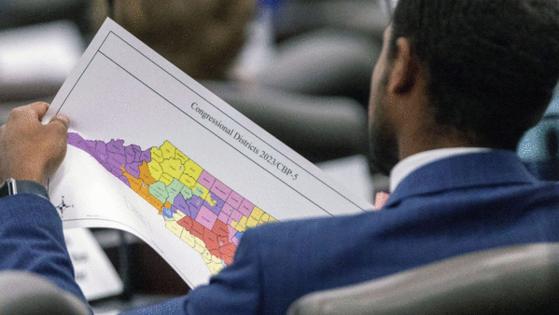North Carolina gets new House map that could help GOP gain additional seat
Published in News & Features
WASHINGTON — North Carolina Republicans have completed their mid-decade redraw of the state’s congressional map, placing a Democrat-held seat in the state’s northeastern corner in jeopardy.
The GOP-led state House gave final approval to the new lines on Wednesday, a day after Republican state senators backed the revised map, under which the GOP would be favored to win 11 of the state’s 14 congressional seats — up one from the current map. Democratic Gov. Josh Stein doesn’t have the power to veto congressional and legislative lines in the Tar Heel State.
The effort in North Carolina is part of a nationwide redistricting push this cycle by President Donald Trump and his allies, who are seeking to bolster Republicans’ chances of maintaining their House majority in 2026.
The redrawn North Carolina map dramatically reshapes the state’s 1st District, a purple swath represented by second-term Democratic Rep. Don Davis, shifting it from a seat that Trump carried by 3 points to one that would have backed him by 12 points, according to data released by the state’s General Assembly.
Davis, in a statement released Tuesday by his campaign, called the redraw “beyond the pale.”
“Since the start of this new term, my office has received 46,616 messages from constituents of different political parties, including those unaffiliated, expressing a range of opinions, views and requests,” he said. “Not a single one of them included a request for a new congressional map redrawing eastern North Carolina.”
In a video posted to social media on Wednesday, Stein accused Republicans of trying to “silence” North Carolina voters in the 2026 elections.
“When a candidate or a party loses an election, you’re supposed to work like hell to connect better with voters so that you can win the next time,” he said. “You do not rig the rules of the game to guarantee your victory, the voters be damned.”
Trump, though, has praised the move, saying on his Truth Social platform last week that the new map would “give the fantastic people of North Carolina the opportunity to elect an additional MAGA Republican in the 2026 Midterm Elections.”
Should the map overcome anticipated legal challenges, it would be the fifth one used for House races in North Carolina in as many election cycles.
Following reapportionment after the 2020 census, North Carolina used a court-approved map for the 2022 cycle, which saw seven Republicans and seven Democrats elected to the House from the battleground state. But after the GOP won control of the state Supreme Court that same year, Republican state lawmakers redrew the map for the 2024 election and went on to flip three Democratic seats last fall.
Under the new congressional map, the boundaries of North Carolina’s 3rd District, held by Republican Greg Murphy, are also changing, with Trump’s winning 2024 margin there dropping from 22 points to around 14 points.
Davis, one of 13 House Democrats who represent districts that backed Trump in 2024, won a second term last year by 2 points. A spokesperson for Davis, whose home in Snow Hill has shifted to the 3rd District, told Spectrum News earlier this week that the congressman would run for reelection from either the 1st or 3rd District should the map be approved.
Murphy is reportedly also weighing running for reelection from either district, but Punchbowl News reported Wednesday that the White House wants him to run for the 3rd District.
Several Republicans are already competing in the 1st District, including Rocky Mount Mayor Sandy Roberson, whose fundraising through Sept. 30 included a net of $2 million in personal loans; state Sen. Bobby Hanig; and Lenoir County Commissioner Eric Rouse. Roberson and Hanig remain residents of the district under the redrawn lines, The Daily Reflector reported, but Rouse is now in the 3rd District.
North Carolina now joins Texas and Missouri among the Republican-controlled states that have opted to heed Trump’s call to redraw their congressional lines. The GOP could pick up as many as seven additional House seats from those three states alone, provided the efforts withstand legal and other challenges.
Democrats in California responded to Texas’ move by redrawing their state’s map in a quest to win five additional seats, although voters would need to approve that plan via a November ballot measure before it can be implemented.
Other mid-decade redistricting efforts are also underway, including in Kansas. Ohio is required under its constitution to redraw its map this cycle, while Utah could also see new congressional lines after a court order.
©2025 CQ-Roll Call, Inc., All Rights Reserved. Visit cqrollcall.com. Distributed by Tribune Content Agency, LLC.







Comments